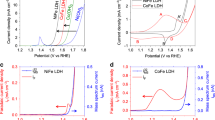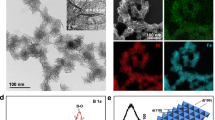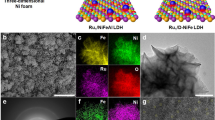Abstract
Nickel-iron layered double hydroxide (NiFe-LDH) nanosheets have shown optimal oxygen evolution reaction (OER) performance; however, the role of the intercalated ions in the OER activity remains unclear. In this work, we show that the activity of the NiFe-LDHs can be tailored by the intercalated anions with different redox potentials. The intercalation of anions with low redox potential (high reducing ability), such as hypophosphites, leads to NiFe-LDHs with low OER overpotential of 240 mV and a small Tafel slope of 36.9 mV/dec, whereas NiFe-LDHs intercalated with anions of high redox potential (low reducing ability), such as fluorion, show a high overpotential of 370 mV and a Tafel slope of 80.8 mV/dec. The OER activity shows a surprising linear correlation with the standard redox potential. Density functional theory calculations and X-ray photoelectron spectroscopy analysis indicate that the intercalated anions alter the electronic structure of metal atoms which exposed at the surface. Anions with low standard redox potential and strong reducing ability transfer more electrons to the hydroxide layers. This increases the electron density of the surface metal sites and stabilizes their high-valence states, whose formation is known as the critical step prior to the OER process.

Similar content being viewed by others
Change history
06 December 2019
The labels in Fig. 8 in the original version of this article were unfortunately misplaced. The corrected figure is as follow.
06 December 2019
The labels in Fig. 8 in the original version of this article were unfortunately misplaced. The corrected figure is as follow.
References
Wang, H. F.; Tang, C.; Zhang, Q. Towards superior oxygen evolution through graphene barriers between metal substrates and hydroxide catalysts. J. Mater. Chem. A2015, 3, 16183–16189.
Cheng, F. Y.; Shen, J.; Peng, B.; Pan, Y. D.; Tao, Z. L.; Chen, J. Rapid room-temperature synthesis of nanocrystalline spinels as oxygen reduction and evolution electrocatalysts. Nat. Chem.2011, 3, 79–84.
Han, N.; Zhao, F. P.; Li, Y. G. Ultrathin nickel-iron layered double hydroxide nanosheets intercalated with molybdate anions for electrocatalytic water oxidation. J. Mater. Chem. A2015, 3, 16348–16353.
Spöri, C.; Kwan, J. T. H.; Bonakdarpour, A.; Wilkinson, D. P.; Strasser, P. The stability challenges of oxygen evolving catalysts: Towards a common fundamental understanding and mitigation of catalyst degradation. Angew. Chem., Int. Ed.2017, 56, 5994–6021.
Zhao, J. W.; Chen, J. L.; Xu, S. M.; Shao, M. F.; Zhang, Q.; Wei, F.; Ma, J.; Wei, M.; Evans, D. G.; Duan, X. Hierarchical NiMn layered double hydroxide/carbon nanotubes architecture with superb energy density for flexible supercapacitors. Adv. Funct. Mater.2014, 24, 2938–2946.
Zhao, M. Q.; Zhang, Q.; Huang, J. Q.; Wei, F. Hierarchical nanocomposites derived from nanocarbons and layered double hydroxides-properties, synthesis, and applications. Adv. Funct. Mater.2012, 22, 675–694.
Burke, M. S.; Enman, L. J.; Batchellor, A. S.; Zou, S. H.; Boettcher, S. W. Oxygen evolution reaction electrocatalysis on transition metal oxides and (Oxy)hydroxides: Activity trends and design principles. Chem. Mater.2015, 27, 7549–7558.
Reier, T.; Nong, H. N.; Teschner, D.; Schlögl, R.; Strasser, P. Electrocatalytic oxygen evolution reaction in acidic environments-reaction mechanisms and catalysts. Adv. Energy Mater.2017, 7, 1601275.
Dionigi, F.; Strasser, P. NiFe-based (Oxy)hydroxide catalysts for oxygen evolution reaction in non-acidic electrolytes. Adv. Energy Mater.2016, 6, 1600621.
Lee, Y.; Suntivich, J.; May, K. J.; Perry, E. E.; Shao-Horn, Y. Synthesis and activities of rutile IrO2 and RuO2 nanoparticles for oxygen evolution in acid and alkaline solutions. J. Phys. Chem. Lett.2012, 3, 399–404.
Diaz-Morales, O.; Raaijman, S.; Kortlever, R.; Kooyman, P. J.; Wezendonk, T.; Gascon, J.; Fu, W. T.; Koper, M. T. M. Iridium-based double perovskites for efficient water oxidation in acid media. Nat. Commun.2016, 7, 12363.
Gong, M.; Dai, H. J. A mini review of NiFe-based materials as highly active oxygen evolution reaction electrocatalysts. Nano Res.2015, 8, 23–39.
Diaz-Morales, O.; Ledezma-Yanez, I.; Koper, M. T. M.; Calle-Vallejo, F. Guidelines for the rational design of Ni-based double hydroxide electrocatalysts for the oxygen evolution reaction. ACS Catal.2015, 5, 5380–5387.
Reier, T.; Oezaslan, M.; Strasser, P. Electrocatalytic oxygen evolution reaction (OER) on Ru, Ir, and Pt catalysts: A comparative study of nanoparticles and bulk materials. ACS Catal.2012, 2, 1765–1772.
Cheng, Y.; Jiang, S. P. Advances in electrocatalysts for oxygen evolution reaction of water electrolysis-from metal oxides to carbon nanotubes. Prog. Nat. Sci.2015, 25, 545–553.
Tian, G. L.; Zhao, M. Q.; Yu, D. S.; Kong, X. Y.; Huang, J. Q.; Zhang, Q.; Wei, F. Graphene hybrids: Nitrogen-doped graphene/carbon nanotube hybrids: In situ formation on bifunctional catalysts and their superior electrocatalytic activity for oxygen evolution/reduction reaction. Small2014, 10, 2113.
Takeguchi, T.; Yamanaka, T.; Takahashi, H.; Watanabe, H.; Kuroki, T.; Nakanishi, H.; Orikasa, Y.; Uchimoto, Y.; Takano, H.; Ohguri, N. et al. Layered perovskite oxide: A reversible air electrode for oxygen evolution/reduction in rechargeable metal-air batteries. J. Am. Chem. Soc.2013, 135, 11125–11130.
Vojvodic, A.; Nørskov, J. K. Optimizing perovskites for the water-splitting reaction. Science2011, 334, 1355–1356.
Grimaud, A.; May, K. J.; Carlton, C. E.; Lee, Y. L.; Risch, M.; Hong, W. T.; Zhou, J. G.; Shao-Horn, Y. Double perovskites as a family of highly active catalysts for oxygen evolution in alkaline solution. Nat. Commun.2013, 4, 2439.
Stern, L. A.; Feng, L. G.; Song, F.; Hu, X. L. Ni2P as a Janus catalyst for water splitting: The oxygen evolution activity of Ni2P nanoparticles. Energy Environ. Sci.2015, 8, 2347–2351.
Chemelewski, W. D.; Lee, H. C.; Lin, J. F.; Bard, A. J.; Mullins, C. B. Amorphous FeOOH oxygen evolution reaction catalyst for photoelectrochemical water splitting. J. Am. Chem. Soc.2014, 136, 2843–2850.
Rosen, J.; Hutchings, G. S.; Jiao, F. Ordered mesoporous cobalt oxide as highly efficient oxygen evolution catalyst. J. Am. Chem. Soc.2013, 135, 4516–4521.
Jahan, M.; Liu, Z. L.; Loh, K. P. A graphene oxide and copper-centered metal organic framework composite as a tri-functional catalyst for HER, OER, and ORR. Adv. Funct. Mater.2013, 23, 5363–5372.
Suntivich, J.; May, K. J.; Gasteiger, H. A.; Goodenough, J. B.; Shao-Horn, Y. A perovskite oxide optimized for oxygen evolution catalysis from molecular orbital principles. Science2011, 334, 1383–1385.
Galizzioli, D.; Tantardini, F.; Trasatti, S. Ruthenium dioxide: A new electrode material. I. Behaviour in acid solutions of inert electrolytes. J. Appl. Electrochem.1974, 4, 57–67.
Zhu, X. L.; Tang, C.; Wang, H. F.; Zhang, Q.; Yang, C. H.; Wei, F. Dual-sized NiFe layered double hydroxides in situ grown on oxygen-decorated self-dispersal nanocarbon as enhanced water oxidation catalysts. J. Mater. Chem. A2015, 3, 24540–24546.
Long, X.; Li, J. K.; Xiao, S.; Yan, K. Y.; Wang, Z. L.; Chen, H. N.; Yang, S. H. A strongly coupled graphene and FeNi double hydroxide hybrid as an excellent electrocatalyst for the oxygen evolution reaction. Angew. Chem., Int. Ed.2014, 53, 7584–7588.
Long, X.; Wang, Z. L.; Xiao, S.; An, Y. M.; Yang, S. H. Transition metal based layered double hydroxides tailored for energy conversion and storage. Mater. Today2016, 19, 213–226.
Gong, M.; Li, Y. G.; Wang, H. L.; Liang, Y. Y.; Wu, J. Z.; Zhou, J. G.; Wang, J.; Regier, T.; Wei, F.; Dai, H. J. An advanced Ni-Fe layered double hydroxide electrocatalyst for water oxidation. J. Am. Chem. Soc.2013, 135, 8452–8455.
Burke, M. S.; Zou, S. H.; Enman, L. J.; Kellon, J. E.; Gabor, C. A.; Pledger, E.; Boettcher, S. W. Revised oxygen evolution reaction activity trends for first-row transition-metal (Oxy)hydroxides in alkaline media. J. Phys. Chem. Lett.2015, 6, 3737–3742.
Song, F.; Hu, X. L. Ultrathin cobalt-manganese layered double hydroxide is an efficient oxygen evolution catalyst. J. Am. Chem. Soc.2014, 136, 16481–16484.
Zhao, Y. F.; Wei, M.; Lu, J.; Wang, Z. L.; Duan, X. Biotemplated hierarchical nanostructure of layered double hydroxides with improved photocatalysis performance. ACS Nano2009, 3, 4009–4016.
Yao, H. B.; Tan, Z. H.; Fang, H. Y.; Yu, S. H. Artificial nacre-like bionanocomposite films from the self-assembly of chitosan-montmorillonite hybrid building blocks. Angew. Chem., Int. Ed.2010, 49, 10127–10131.
Han, Y. F.; Liu, Z. H.; Yang, Z. P.; Wang, Z. L.; Tang, X. H.; Wang, T.; Fan, L. H.; Ooi, K. Preparation of Ni2+−Fe3+ layered double hydroxide material with high crystallinity and well-defined hexagonal shapes. Chem. Mater.2008, 20, 360–363.
Louie, M. W.; Bell, A. T. An investigation of thin-film Ni–Fe oxide catalysts for the electrochemical evolution of oxygen. J. Am. Chem. Soc.2013, 135, 12329–12337.
Chen, J. Y. C.; Miller, J. T.; Gerken, J. B.; Stahl, S. S. Inverse spinel NiFeAlO4 as a highly active oxygen evolution electrocatalyst: Promotion of activity by a redox-inert metal ion. Energy Environ. Sci.2014, 7, 1382–1386.
Tang, C.; Wang, H. S.; Wang, H. F.; Zhang, Q.; Tian, G. L.; Nie, J. Q.; Wei, F. Spatially confined hybridization of nanometer-sized NiFe hydroxides into nitrogen-doped graphene frameworks leading to superior oxygen evolution reactivity. Adv. Mater.2015, 27, 4516–4522.
Chen, S.; Duan, J. J.; Jaroniec, M.; Qiao, S. Z. Three-dimensional N-doped graphene hydrogel/NiCo double hydroxide electrocatalysts for highly efficient oxygen evolution. Angew. Chem., Int. Ed.2013, 52, 13567–13570.
Ma, W.; Ma, R. Z.; Wang, C. X.; Liang, J. B.; Liu, X. H.; Zhou, K. C.; Sasaki, T. A superlattice of alternately stacked Ni-Fe hydroxide nanosheets and graphene for efficient splitting of water. ACS Nano2015, 9, 1977–1984.
Song, F.; Hu, X. L. Exfoliation of layered double hydroxides for enhanced oxygen evolution catalysis. Nat. Commun.2014, 5, 4477.
Wang, L.; Wang, D.; Dong, X. Y.; Zhang, Z. J.; Pei, X. F.; Chen, X. J.; Chen, B.; Jin, J. Layered assembly of graphene oxide and Co-Al layered double hydroxide nanosheets as electrode materials for supercapacitors. Chem. Commun.2011, 47, 3556–3558.
Oliver-Tolentino, M. A.; Vázquez-Samperio, J.; Manzo-Robledo, A.; de Guadalupe González-Huerta, R.; Flores-Moreno, J. L.; Ramírez-Rosales, D.; Guzmán-Vargas, A. An approach to understanding the electrocatalytic activity enhancement by superexchange interaction toward OER in alkaline media of Ni–Fe LDH. J. Phys. Chem. C2014, 118, 22432–22438.
Wang, Q.; O’Hare, D. Recent advances in the synthesis and application of layered double hydroxide (LDH) nanosheets. Chem. Rev.2012, 112, 4124–4155.
Hunter, B. M.; Hieringer, W.; Winkler, J. R.; Gray, H. B.; Müller, A. M. Effect of interlayer anions on [NiFe]-LDH nanosheet water oxidation activity. Energy Environ. Sci.2016, 9, 1734–1743.
Luo, M.; Cai, Z.; Wang, C.; Bi, Y. M.; Qian, L.; Hao, Y. C.; Li, L.; Kuang, Y.; Li, Y. P.; Lei, X. D. et al. Phosphorus oxoanion-intercalated layered double hydroxides for high-performance oxygen evolution. Nano Res.2017, 10, 1732–1739.
Brandán, S. A. Theoretical study of the structure and vibrational spectra of chromyl perchlorate, CrO2(ClO4)2. J. Mol. Struct.2009, 908, 19–25.
Hunt, J. M.; Wisherd, M. P.; Bonham, L. C. Infrared absorption spectra of minerals and other inorganic compounds. Anal. Chem.1950, 22, 1478–1497.
Miller, F. A.; Wilkins, C. H. Infrared spectra and characteristic frequencies of inorganic ions. Anal. Chem.1952, 24, 1253–1294.
Institute of Inorganic Chemistry of Science and Engineering University of Dalian. Inorganic Chemistry; 4th ed. Higher Education Press: Beijing, 2001.
Wagman, D. D.; William, H. E.; Parker, V. B.; HandHalow, R.; Schumm, I.; Bailey, S. M.; Churney, K. L.; Nuttall, R. L. The NBS tables of chemical thermodynamic properties: Selected values for inorganic and C1 and C2 organic substances in SI units; American Chemical Society, American Institute of Physics for the National Bureau of Standards: New York, 1982.
Lu, Z. Y.; Qian, L.; Tian, Y.; Li, Y. P.; Sun, X. M.; Duan, X. Ternary NiFeMn layered double hydroxides as highly-efficient oxygen evolution catalysts. Chem. Commun.2016, 52, 908–911.
Batchellor, A. S.; Boettcher, S. W. Pulse-electrodeposited Ni–Fe (Oxy)hydroxide oxygen evolution electrocatalysts with high geometric and intrinsic activities at large mass loadings. ACS Catal.2015, 5, 6680–6689.
McCrory, C. C. L.; Jung, S.; Ferrer, I. M.; Chatman, S. M.; Peters, J. C.; Jaramillo, T. F. Benchmarking hydrogen evolving reaction and oxygen evolving reaction electrocatalysts for solar water splitting devices. J. Am. Chem. Soc.2015, 137, 4347–4357.
Stevens, M. B.; Enman, L. J.; Batchellor, A. S.; Cosby, M. R.; Vise, A. E.; Trang, C. D. M.; Boettcher, S. W. Measurement techniques for the study of thin film heterogeneous water oxidation electrocatalysts. Chem. Mater.2017, 29, 120–140.
Laubach, S.; Laubach, S.; Schmidt, P. C.; Ensling, D.; Schmid, S.; Jaegermann, W.; Thißen, A.; Nikolowski, K.; Ehrenberg, H. Changes in the crystal and electronic structure of LiCoO2 and LiNiO2 upon Li intercalation and de-intercalation. Phys. Chem. Chem. Phys.2009, 11, 3278–3289.
Lu, Z. Y.; Wang, H. T.; Kong, D. S.; Yan, K.; Hsu, P. C.; Zheng, G. Y.; Yao, H. B.; Liang, Z.; Sun, X. M.; Cui, Y. Electrochemical tuning of layered lithium transition metal oxides for improvement of oxygen evolution reaction. Nat. Commun.2014, 5, 4345.
Rossmeisl, J.; Dimitrievski, K.; Siegbahn, P.; Nørskov, J. K. Comparing electrochemical and biological water splitting. J. Phys. Chem. C2007, 111, 18821–18823.
Valdés, Á.; Qu, Z. W.; Kroes, G. J.; Rossmeisl, J.; Nørskov, J. K. Oxidation and photo-oxidation of water on TiO2 surface. J. Phys. Chem. C2008, 112, 9872–9879.
Yeo, B. S.; Bell, A. T. Enhanced activity of gold-supported cobalt oxide for the electrochemical evolution of oxygen. J. Am. Chem. Soc.2011, 133, 5587–5593.
Lu, X. Y.; Zhao, C. Electrodeposition of hierarchically structured three-dimensional nickel-iron electrodes for efficient oxygen evolution at high current densities. Nat. Commun.2015, 6, 6616.
Trotochaud, L.; Young, S. L.; Ranney, J. K.; Boettcher, S. W. Nickel-iron oxyhydroxide oxygen-evolution electrocatalysts: The role of intentional and incidental iron incorporation. J. Am. Chem. Soc.2014, 136, 6744–6753.
Friebel, D.; Louie, M. W.; Bajdich, M.; Sanwald, K. E.; Cai, Y.; Wise, A. M.; Cheng, M. J.; Sokaras, D.; Weng, T. C.; Alonso-Mori, R. et al. Identification of highly active Fe sites in (Ni, Fe)OOH for electrocatalytic water splitting. J. Am. Chem. Soc.2015, 137, 1305–1313.
Liao, P. L.; Keith, J. A.; Carter, E. A. Water oxidation on pure and doped hematite (0001) surfaces: Prediction of Co and Ni as effective dopants for electrocatalysis. J. Am. Chem. Soc.2012, 134, 13296–13309.
Lu, Z. Y.; Xu, W. W.; Zhu, W.; Yang, Q.; Lei, X. D.; Liu, J. F.; Li, Y. P.; Sun, X. M.; Duan, X. Three-dimensional NiFe layered double hydroxide film for high-efficiency oxygen evolution reaction. Chem. Commun.2014, 50, 6479–6482.
Acknowledgements
This work was supported by the National Natural Science Foundation of China (NSFC), the National Key Research and Development Project (Nos. 2016YFF0204402 and 2016YFC0801302), the Program for Changjiang Scholars, and innovative Research Team in the University, and the Fundamental Research Funds for the Central Universities, and the long term subsidy mechanism from the Ministry of Finance and the Ministry of Education of China. S.S. gratefully acknowledges Villum Foundation.
Author information
Authors and Affiliations
Corresponding authors
Electronic supplementary material
12274_2017_1750_MOESM1_ESM.pdf
Effects of redox-active interlayer anions on the oxygen evolution reactivity of NiFe-layered double hydroxide nanosheets
Rights and permissions
About this article
Cite this article
Zhou, D., Cai, Z., Bi, Y. et al. Effects of redox-active interlayer anions on the oxygen evolution reactivity of NiFe-layered double hydroxide nanosheets. Nano Res. 11, 1358–1368 (2018). https://doi.org/10.1007/s12274-017-1750-9
Received:
Revised:
Accepted:
Published:
Issue Date:
DOI: https://doi.org/10.1007/s12274-017-1750-9




